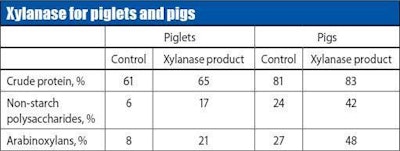Maize-soya diets amount to a much greater proportion of rations for monogastrics today than a decade ago. As biofuel industry competition for corn and soybeans increases their cost, feed formulators are going to search out means to extract more nutrition from the feedstuffs. They are likely to seek increasingly efficient means to increase nutrient bioavailability from maize-soya blends as well as from corn ethanol co-products and others. Bringing feed-grade enzymes to bear on the non-starch polysaccharides in the cell walls of these feedstuffs is likely to be an increasingly attractive option.
In the case of poultry, researcher Dr Pierre Dalibard with the feed ingredient supplier Adisseo, based in France, notes that cell walls of conventional vegetable feedstuffs, including corn and soybeans, contain significant quantities of non-starch polysaccharides (NSP). Even soybean meal contains 210-220 grams NSP per kilogram of dry matter, with more than half composed of pectins as well as oligosaccharides of the agalactoside series (raffinose, stachyose, and verbascose). Poultry lack the digestive enzymes to decompose most NSP, which is the rationale supporting use of NSP-enzyme feed additives to improve digestibility and bioavailability of nutrients even in relatively digestible maize-soya diets.
 0610FIenzyme_table1
0610FIenzyme_table1
Effect of a commercial xylanase product (RONOZYME WX) on the ileal digestibility (%) of crude protein and the degradation (%) of arabinoxylan (arabinose + xylose) and non-starch polysaccharides in pigs and piglets receiving cereal-based diets. Source: Data compiled from two trials conducted at Research Center Foulum, Denmark in 1998 and 2001, Pettersson and Korsbak, 2006.
Poultry: Metabolisable energy and beyond
One approach is through NSP-enzyme additives with multi-enzyme activity applicable to a wide range of maize-soya diets. Dr Dalibard notes that an advanced multi-enzyme product may include some 19 enzymatic activities, including activities of rhamnogalacturonase and alpha-galactosidase for NSP in soybean. He points out that digestibility tests show that NSP-enzymes in corn and soybean meal-based rations for broiler chickens and turkeys can increase metabolisable energy of the NSP fraction by up to 65% kcal/kg.
"Moreover," Dr Dalibard says, "results of the performance tests show an average improvement of at least 2% of the feed conversion, depending on species."
He adds that a recent test with layers fed corn-based diets demonstrated a significant reduction of feed consumption, resulting in a significant decrease of feed conversion by 5.8%. Also, he says there are benefits in the poultry house environment, due to drier droppings and less ammonia excretion.
Dr Dalibard attributes return-on-investment advantages to the capability to reduce the metabolisable energy value of the complete feed with NSP-enzymes or to apply specific metabolisable energy values the NSP-enzymes effect on individual ingredients, such as corn or soybean meal. However, with drier litter and reduced ammonia, he says the birds' viability is better, "and there is a far smaller risk of respiratory illnesses" or health effects in farm workers. Moreover, Dr Dalibard says: "At the end of their growth, animals are more homogeneous and therefore have a much greater value at the moment they are slaughtered. Owing to cleaner litters, poultry suffer less from skin lesions. When all is considered, this implies less downgrading when poultry are slaughtered."
For layers, Dr Dalibard suggests NSP-enzymes offer similar advantages; less humid droppings which result in cleaner eggs and less downgrading. Also, the enzymes enhance lipid digestibility, such that the natural pigmentswhich are fat-solubleare better absorbed: "The egg yolk is of a much brighter colourbetween 0.2 and 1 point on the Roche scale. In some countries, this factor takes on a considerable commercial importance and allows feed producers to add less pigment to the feed they give to their layers."
Pigs: Pelleting priority
Drs Dan Pettersson of Novozymes in Denmark and Arne Korsbak of DSM in Switzerland suggest that additives for multi-enzymatic action in pig diets should have a high level of thermal stability in order to withstand typical steam-conditioned pelleting temperatures. They note that many xylanase feed enzyme products derive from Trichoderma, Bacillus, or Apergillus micro organisms. However, more heat stable xylanases can be obtained from Thermomyces lanuginosus with at least one commercial enzyme product retaining 80% of its activity when exposed to steam conditioning for 30 seconds at 90°C prior to pelleting. This product, they note, also has a high affinity for both insoluble as well as soluble arabinoxylans, "thereby achieving a high total degradation capacity" (see figure).
Drs Pettersson and Korsbak point to ileal digestibility trials in piglets and pigs, demonstrating the capacity of this multi-enzyme additive to degrade arabinoxylan (calculated as the sum of arabinose and xylose) and polysaccharides and improve nutrient digestion (see table).
"The effect of xylanase supplementation on nutrient digestibility may be more pronounced in piglets as compared to pigs," they noted. "However, it was noticeable in both trials, that the xylanase degraded the fibre fraction. This is a prerequisite for improving nutrient absorption and, although small, there still was an enzyme response in nutrient digestion observed in the pigs."
The researchers note that their work highlights the importance of adjusting nutrient contents in pig diets in order to take advantage of the capacity of the xylanase to reduce gut viscosity by degrading soluble xylans, as well as solubilising the insoluble xylans. They add: "The latter effect will assist in releasing nutrients entrapped by the cell wall architecture, such as in the aleurone cells."















